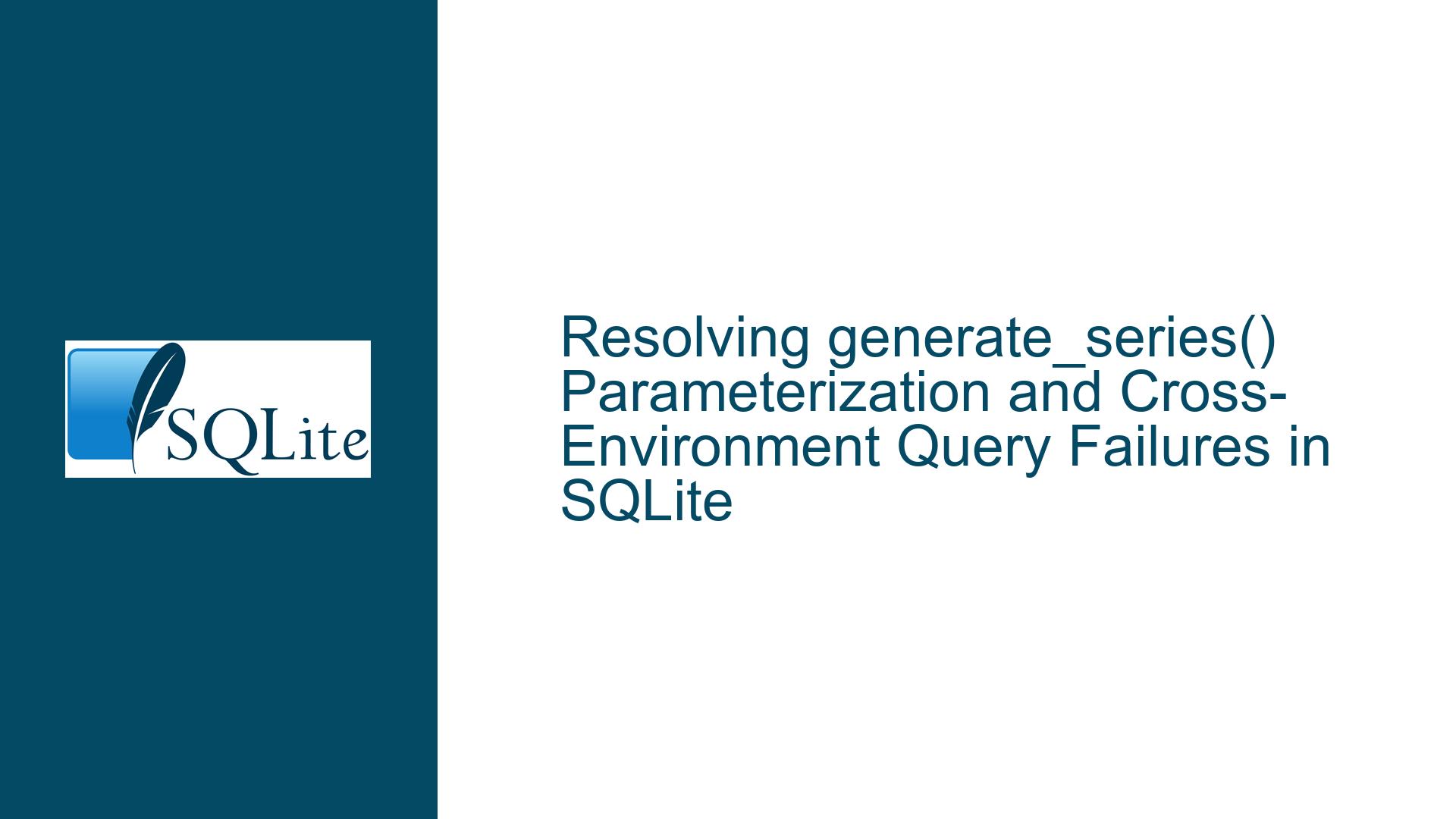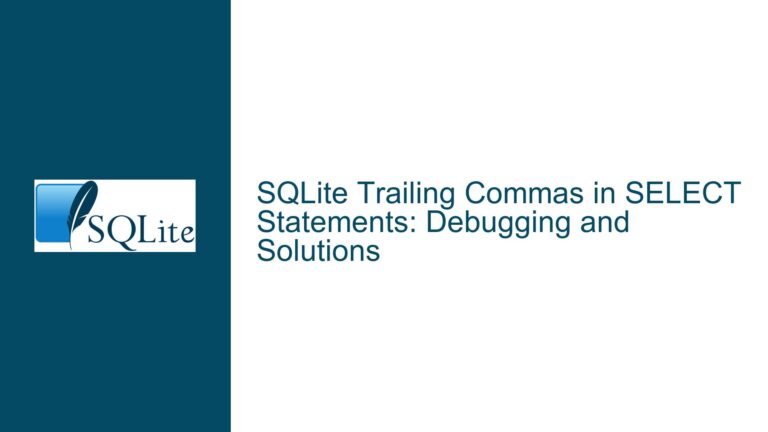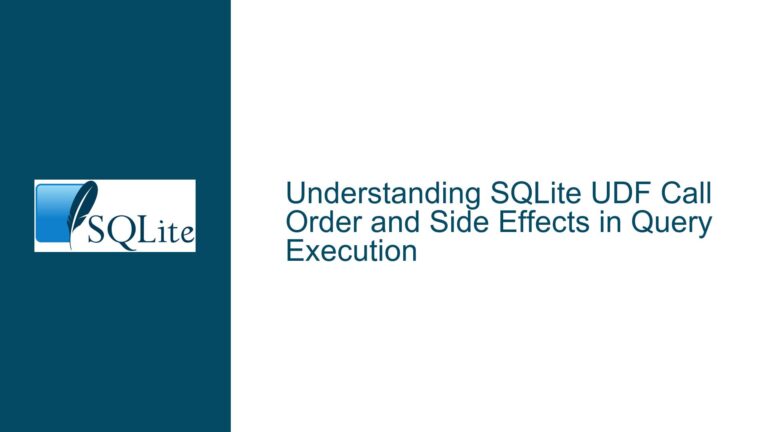Resolving generate_series() Parameterization and Cross-Environment Query Failures in SQLite
Issue Overview: generate_series() Produces No Rows in C# Despite Working in SQLStudio
The core issue involves a SQLite query utilizing the generate_series() table-valued function that executes successfully in SQLStudio but returns no rows when run in a C# application after loading the series extension. The query joins the CircuitBreaker table with two generate_series() calls parameterized by column values from CircuitBreaker. When static values replace these dynamic column-based parameters, the query functions correctly in both environments. The discrepancy arises from syntax ambiguities, parameterization logic, and cross-environment differences in SQLite configuration or query execution plans.
Key components of the problem include:
- Dynamic Parameter Construction: The
generate_series(start, end, step)arguments derive from arithmetic operations on columns (e.g.,cb.IrMin * cb.Current), introducing runtime evaluation dependencies. - Syntax Ambiguities: Misplaced operators or missing delimiters in arithmetic expressions (e.g.,
cb.IrMax_ cb.Currentinstead ofcb.IrMax * cb.Current) cause parameter misinterpretation. - Cross-Environment Behavior: Differences in SQLite versions, extension loading mechanisms, or query optimization strategies between SQLStudio and C# lead to divergent outcomes.
The query’s reliance on implicit joins (comma-separated tables) and column-derived parameters creates fragility that manifests differently across execution contexts.
Possible Causes: Syntax Errors, Parameter Misalignment, and Join Semantics
1. Syntax Errors in Arithmetic Expressions
The original query contains malformed arithmetic expressions in the generate_series() parameters. For example:
generate_series(cb.IrMin _cb.Current, cb.IrMax_ cb.Current, ...)
Here, the operator between cb.IrMin and cb.Current is missing (likely *), and cb.IrMax_ is mistyped as cb.IrMax with an underscore. Such errors cause SQLite to misinterpret the parameters, leading to invalid ranges or step values.
Why This Causes Failure:
- SQLite’s parser treats
cb.IrMin _cb.Currentas a single identifier due to the missing operator, resulting in a syntax error or a non-numeric value. - In environments with stricter parsing (e.g., some C# SQLite drivers), this halts execution entirely, whereas SQLStudio might tolerate or autocorrect the error.
2. Implicit Join Order and Cartesian Product Miscalculations
The query uses implicit cross-joins by listing CircuitBreaker, generate_series(), and another generate_series() in the FROM clause:
FROM CircuitBreaker cb, generate_series(...) gs1, generate_series(...) gs2
This syntax creates a Cartesian product between CircuitBreaker and both generate_series() calls. However, if either generate_series() call produces zero rows (due to invalid parameters), the entire result set becomes empty.
Why This Causes Failure:
- In C#, the parameterized
generate_series()calls might evaluate to empty sets (e.g., invalid start/end/step combinations), while static values avoid this. - SQLStudio might precompute or cache metadata about the
CircuitBreakercolumns, allowinggenerate_series()to resolve parameters correctly, whereas C# evaluates parameters at runtime with stricter type checking.
3. Step Value Sign and Directionality
The step parameter in generate_series() must be negative if the start value is greater than the end value. The original query calculates the step as:
(cb.IrMin * cb.Current - cb.IrMax * cb.Current) / 3
If IrMin * Current > IrMax * Current, this results in a positive step value, causing generate_series() to return no rows because it cannot increment from a higher start to a lower end.
Why This Causes Failure:
- SQLStudio might implicitly adjust the step sign or tolerate misconfigured ranges, while C# drivers enforce stricter adherence to the
generate_series()specification.
Troubleshooting Steps, Solutions & Fixes
1. Validate and Correct Syntax in generate_series() Parameters
Step 1: Identify and Fix Missing Operators
Replace mistyped operators and ensure proper arithmetic syntax:
-- Original (incorrect)
generate_series(cb.IrMin _cb.Current, cb.IrMax_ cb.Current, ...)
-- Corrected
generate_series(cb.IrMin * cb.Current, cb.IrMax * cb.Current, ...)
Step 2: Verify Parameter Data Types
Ensure that all parameters evaluate to numeric values. Use CAST if necessary:
generate_series(CAST(cb.IrMin AS REAL) * cb.Current, ...)
2. Explicitly Define Joins and Handle Empty Results
Step 1: Use CROSS JOIN for Clarity
Replace implicit joins with explicit CROSS JOIN syntax to clarify the relationships:
FROM CircuitBreaker cb
CROSS JOIN generate_series(...) gs1
CROSS JOIN generate_series(...) gs2
Step 2: Guard Against Empty generate_series() Output
Use COALESCE or IIF to ensure non-empty ranges:
generate_series(
cb.IrMin * cb.Current,
cb.IrMax * cb.Current,
IIF(cb.IrMin * cb.Current <= cb.IrMax * cb.Current,
(cb.IrMax * cb.Current - cb.IrMin * cb.Current) / 3,
(cb.IrMin * cb.Current - cb.IrMax * cb.Current) / -3 -- Negative step
)
)
3. Standardize Step Calculation Logic
Step 1: Compute Step Direction Programmatically
Calculate the step based on the relative values of start and end:
SELECT
cb.Name,
cb.Current,
gs1.value AS IrSet,
gs2.value AS IiSet
FROM CircuitBreaker cb
CROSS JOIN generate_series(
cb.IrMin * cb.Current,
cb.IrMax * cb.Current,
CASE
WHEN cb.IrMin * cb.Current <= cb.IrMax * cb.Current
THEN (cb.IrMax * cb.Current - cb.IrMin * cb.Current) / 3
ELSE -1 * (cb.IrMin * cb.Current - cb.IrMax * cb.Current) / 3
END
) gs1
CROSS JOIN generate_series(
cb.IiMin * cb.Current,
cb.IiMax * cb.Current,
CASE
WHEN cb.IiMin * cb.Current <= cb.IiMax * cb.Current
THEN (cb.IiMax * cb.Current - cb.IiMin * cb.Current) / 5
ELSE -1 * (cb.IiMin * cb.Current - cb.IiMax * cb.Current) / 5
END
) gs2
LIMIT 4;
4. Debug Cross-Environment Discrepancies
Step 1: Compare SQLite Versions and Extensions
Ensure the C# application uses the same SQLite version and series extension as SQLStudio. Check extension loading:
connection.LoadExtension("series.dll", null); // Verify path and permissions
Step 2: Log and Compare Query Execution Plans
Capture the query execution plan in both environments using EXPLAIN QUERY PLAN:
EXPLAIN QUERY PLAN
SELECT ...; -- Run in SQLStudio and C#
Compare the outputs to identify differences in join order or function evaluation.
5. Refactor Query Structure for Reliability
Option 1: Use Subqueries for Parameter Isolation
Isolate generate_series() parameters in subqueries to precompute values:
SELECT
cb.Name,
cb.Current,
gs1.value AS IrSet,
gs2.value AS IiSet
FROM (
SELECT
*,
IrMin * Current AS IrStart,
IrMax * Current AS IrEnd,
(IrEnd - IrStart) / 3 AS IrStep
FROM CircuitBreaker
) cb
CROSS JOIN generate_series(IrStart, IrEnd, IrStep) gs1
CROSS JOIN generate_series(
IiMin * Current,
IiMax * Current,
(IiMax * Current - IiMin * Current) / 5
) gs2
LIMIT 4;
Option 2: Move generate_series() to SELECT Clause
Use generate_series() as a correlated subquery (SQLite 3.30+):
SELECT
cb.Name,
cb.Current,
ir.value AS IrSet,
ii.value AS IiSet
FROM CircuitBreaker cb,
generate_series(cb.IrMin * cb.Current, cb.IrMax * cb.Current, ...) ir,
generate_series(cb.IiMin * cb.Current, cb.IiMax * cb.Current, ...) ii
LIMIT 4;
6. Validate Data Ranges and Step Precision
Step 1: Inspect CircuitBreaker Column Values
Run a diagnostic query to identify invalid ranges:
SELECT
IrMin * Current AS IrStart,
IrMax * Current AS IrEnd,
(IrEnd - IrStart) / 3 AS IrStep,
IiMin * Current AS IiStart,
IiMax * Current AS IiEnd,
(IiEnd - IiStart) / 5 AS IiStep
FROM CircuitBreaker;
Ensure IrStart <= IrEnd (or vice versa with negative steps) and that steps are non-zero.
Step 2: Handle Floating-Point Division
Use CAST to avoid integer division truncation:
(CAST(cb.IrMax * cb.Current - cb.IrMin * cb.Current AS REAL) / 3)
By systematically addressing syntax errors, join semantics, parameter logic, and environmental factors, the query can be stabilized to produce consistent results across SQLStudio and C# applications.






